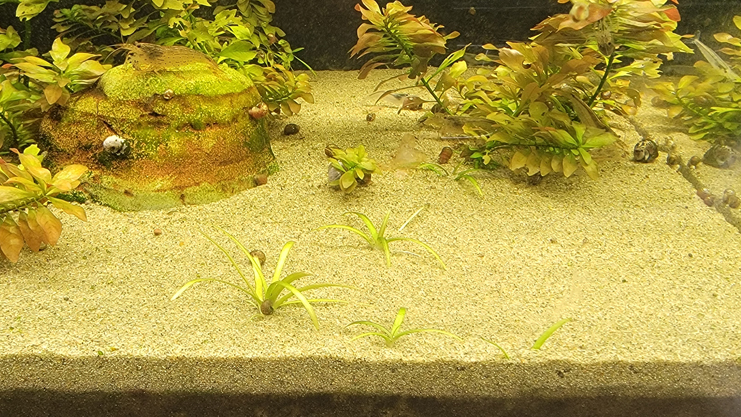Substrate
Substrate plays an important part in the health of an aquarium ecosystem. Substrate is colonized by both aerobic and anaerobic bacteria, that aid in the nitrification of ammonia and nitrite, and the denitrification of nitrate. The substrate develops overtime separate and distinct environments within the bed.
Depending on the size of the substrate that is used, different populations of bacteria will develop at different depths in the bed. On the top layer of the substrate that is in contract with the oxygen rich water column, high densities of aerobic bacteria that are responsible for the nitrification of ammonia and nitrite will develop. In the lower depths of the substrate where very little water is exchanged, a anaerobic (no oxygen) environment develops, that is the primary habitat of anaerobic bacteria. Anaerobic bacteria use the oxygen in nitrate to respire. The anaerobic bacteria that breaks down the nitrate will eventually release nitrogen gas (non-toxic) that will bubble out of the aquarium.
Fine grain sand will develop an anaerobic layer at a shallow depth in as little as ¼ inch (6 mm) in depth. The larger the substrate size, the greater the depth needs to be before the aquarium ecosystem can benefit from denitrification. Larger substrates marketed for aquarium use may require several inches before an anaerobic layer will develop.

Substrate comes in many sizes and colors. The color of the substrate can affect how dark some fishes color will be displayed. Some species of fish will have a darker color over dark substrate. The size of the substrate should also be considered, depending on the type of fish, plants, filtration, and spawning behavior.
For most modern aquarium systems, sand is the preferred substrate. Sand has many benefits:
If you are using an UG filter you need to make sure that the substrate you use is not so small or it will slip through the slits in the filter plate.
You will commonly see artificially colored gravel for sale in many aquarium and pet shops. These colored gravels are often painted and epoxy coated dolomite. Dolomite can affect the pH and hardness of the water when the epoxy coating wears off.
Advanced aquarists typically try to make the aquarium as natural as possible, therefore they use natural gravel or sand. Most natural substrates do not affect water chemistry, but there are some available that will raise the pH and hardness.
Fish that come from hard alkaline water will often benefit from aragonite (coral sand), dolomite, or calcite as a substrate. Aragonite is primarily calcium carbonate, strontium, and some magnesium. Dolomite is about 50/50 calcium carbonate and magnesium. Calcite is primarily calcium carbonate and magnesium. Natural substrates that have pieces of shell can also be good for hard alkaline water fish.

Many suitable natural substrates can be found at rock and landscape material suppliers, hardware/home improvement stores as well as good aquarium shops and pet stores.
A good aquarium substrate should never raise ammonia, nitrite, or nitrate level. In the past I have done independent test for a aquarium products manufacturer on substrate a supplier in Asia wanted the manufacturer to sell under their brand name. The aquarium was set up with the substrate and no plants, or fish. Ammonia, nitrite, and nitrate were all detected after a short time. The nitrate continued to rise as long as the system was set up. Based on my finding, the manufacturer rejected the product. Although I have not tested many substrates marketed of planted aquariums, I have seen some that looked similar to the product mentioned in this paragraph under another brand.
Whatever gravel or sand you use, you should wash it out before you introduce it into the aquarium. New gravel has lots of dust and dirt mixed in that should be washed out or it will make the water cloudy. If you plan on keeping live plants, it is best to use small grain gravel or sand. The substrate should be at least two inches (5 cm) deep for plants. The substrate should be added to the aquarium before adding water. A plate can be laid on top of the substrate, and then water can be poured into the aquarium slowly on the plate so the substrate does not get disturbed.
Although the anaerobic bacteria in the substrate can aid in the reduction of nitrate it is not as effective as plants. Anaerobic bacteria need alkaline water for heavy populations to develop in the substrate. Stocking with fish that sift sand, Malaysian Livebearing Snails (Malaysian Trumpet Snails) that burrow in the sand, and California Blackworms that also burrow in the sand can help turn the substrate over slowly to allow new water to circulate through the bed.